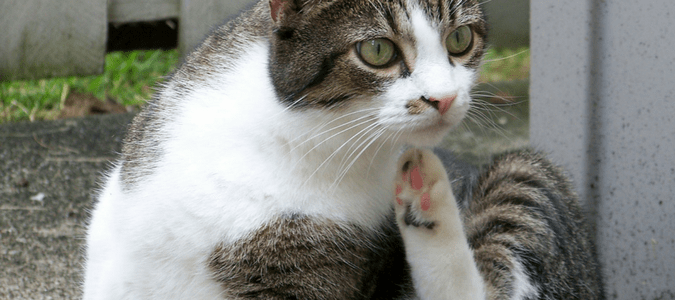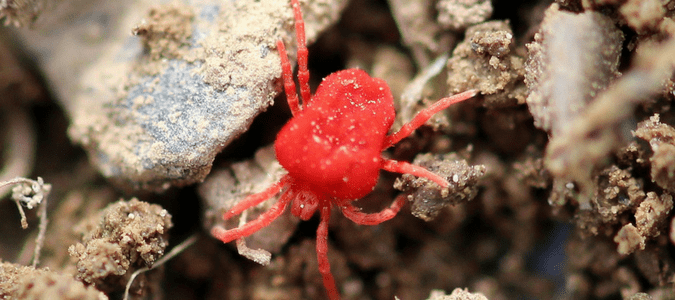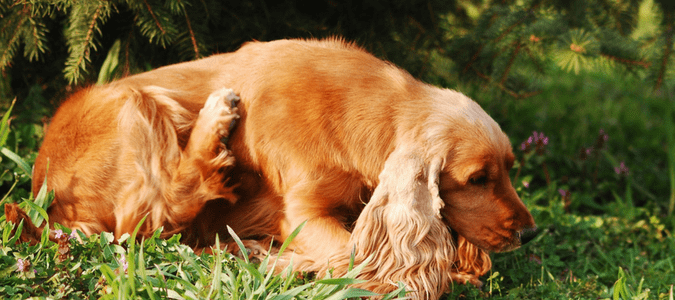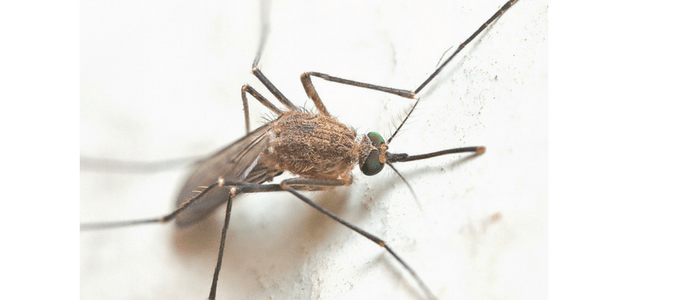
If you’ve ever found itchy red welts on your ankles or other parts of your body, you might have wondered if you’d encountered a flea—or a whole pack of them. These tiny, annoying insects feed off animal blood, which means they bite humans as well as other animals. Thus, when they infest your pet or your home, they can become quite a nuisance.
But how much do you really know about fleas? Do fleas have wings? How does a flea move? What other insects share similar characteristics? Read on to find answers to all your many flea questions, including how to identify them and—perhaps most importantly—how to get rid of them when you’re dealing with a flea infestation.
Do Fleas Have Wings?
While it might seem as if fleas can fly—they certainly do move quickly—they actually can’t. These members of the insect order of Siphonaptera don’t have wings. (Their order’s suffix, aptera, actually means wingless in Greek.) Similarly, chiggers also don’t have wings, but they do bite humans when the opportunity arises, leaving behind welts that are even itchier—and itchy for longer—than those caused by flea bites.)
Now that you know that fleas don’t move by flying, what other things might you want to know about these creatures and other little creepy crawlies? Read on to learn more.

Bugs That Look Like Fleas But Fly
If you spot bugs that look like fleas but fly, it’s a sure bet they’re something other than a flea—probably gnats or small flies. The most common type of small flying insect we usually see around our homes is the fruit fly, which we can bring in on produce and which is attracted to the smell of rotting fruits and vegetables. Another type of tiny bug with wings is the fungus gnat, which tends to hang out around houseplants or near a window and which feed on houseplants.
Other small insects that might be mistaken for fleas that don’t have wings are springtails, black carpet beetles, flour beetles and dog ticks. Although these bugs don’t fly, cigarette or drugstore beetles look similar to fleas and have wings.

Do Mites Have Wings?
Mites are very small arthropods which are closely related to ticks. Most mites are harmless, but several species do bite humans. Some types of mites feed on products in our pantries, including grains. Like fleas, mites don’t have wings, but they can cause rashes and itching in animals when they bite.
There are thousands of mite species, and all of them are quite small, like fleas. Mites can live on land or in water. Some species are predatory, some feed on decaying matter and others are considered agricultural pests.

How Does a Flea Move?
Without wings, how does a flea move around? Like most insects, fleas use their legs to walk, which is how they move around among the hairs of their host animal. When they need to move farther or more quickly, however, fleas use those tiny, powerful legs to jump.
Interestingly, fleas reverse directions each time they jump. While they can actually jump as high as eight inches, they prefer to stay nestled in the fur of their warm, comfortable host animal.

Do Gnats Have Wings?
If you come across another small insect that has wings, you might have encountered a gnat. These tiny, black, flying insects are about the same size as a flea, but, thank goodness, most species don’t bite humans or animals.
Gnats live off rotten or decaying material and are more prevalent during the winter months. Gnats are often commonly mistaken for fruit flies which we see in our kitchens when they feed on bananas and other organic matter.
Some Interesting Flea Facts
Now that we have answered some of the more common questions about fleas and other small bugs, let’s learn more about this common household pest.
Lifespan
Fleas have a lifespan of several months, and may live up to a full year, during which time female fleas can produce hundreds or even thousands of offspring. This is why a flea infestation in your home can become such a critical problem, in need of a quick and thorough solution.
Diet and Habitat
Fleas prefer to feed on the blood of warm-blooded mammals, but they can also feed on the blood of cold-blooded animals such as birds and reptiles. Fleas typically live on the bodies of their hosts (the animals whose fur they infest). Fortunately, humans aren’t hairy enough to be good hosts for flea colonies. Fleas can and do bite humans, of course, but they won’t take up long-term residence in our hair.
They will happily, however, live out their days on our pets. Fleas love to infest domesticated animals like pet cats, dogs, rabbits and small rodents. They also infest wild animals such as rats, squirrels, skunks and raccoons. Furthermore, when fleas infest a home, they can live for days or even up to a couple of weeks in carpets or blankets without needing to feed. Of course, they can’t live away from a host forever; they need to feed at some point to survive. Thus, if you find fleas that seem to be living in your carpet or bed, it’s more likely they are simply jumping around, searching for their next tasty meal. Still, even one flea hopping around while you’re cuddled up in your favorite blanket is a serious nuisance!
Fleas prefer a temperate climate; they don’t do well in either extreme heat or extreme cold. Unfortunately, that’s why these insects love living indoors with humans and pets. They find the same conditions comfortable that we do, and they thrive in our air-conditioned living spaces.
Effects on Humans and Pets
The red, itchy bumps left behind by their bites are the most common way that fleas affect humans, but it’s far from the only effect these small insects can have on us and our pets. Though bubonic plague is very rare, fleas are actually carriers of this disease. Far more commonly, both humans and pets can have allergic dermatitis reactions to fleas’ saliva. Fleas can also cause anemia and tapeworms in animals.
How to Identify Fleas
Like most other insects, a flea has a head, thorax, abdomen and six legs. These insects are very small—just a millimeter or two across when full-grown—and their dark reddish-brown coloring may appear black. Fleas’ bodies are flat, which helps them move easily among the hairs of an animal; this feature also makes them tricky to hold on to if you catch one between your fingers.
Fleas are relatively easy to find on an animal: Simply use your fingers to separate a dog or cat’s fur and take a look at its skin. If fleas are present, you should be able to glimpse their small, dark bodies weaving between the hairs. Since fleas prefer darkness, they will attempt to hide when exposed to the light, so even if you catch sight of one, it’s likely to disappear quickly. You also might spot “flea dirt”—really flea droppings, which look like tiny black dots or a fine dusting of dirt on the animal’s skin.
You’re also likely to see evidence of fleas in the form of bites. Flea bites on humans are red, itchy spots or welts. On animals, flea bites might appear as small red dots or welts, but they might also appear as one large, red, irritated patch of skin. While flea bites themselves cause itching, they can also cause a secondary allergic reaction on both human and animal skin. Animals with fleas might even develop bald patches where the exposed skin is red, rough, flaky or scaly, and irritated. If your pet is scratching repeatedly, there’s a good chance they are suffering from flea bites.
What to Do About Flea Bites
Fortunately, for most people, flea bites are nothing more than a short-term, itchy annoyance. Over-the-counter anti-itch creams can be helpful in relieving the itch caused by flea bites, as can natural remedies such as tea tree oil, witch hazel and aloe vera gel. Antihistamine medications can also be helpful if you have an allergic reaction to the bites.
As with any bug bite, it’s best to avoid scratching your bites, since scratching too vigorously can cause a secondary infection. Be sure to visit a doctor if your flea bite symptoms worsen or a rash or infection develops at the site.

Signs That Fleas Are Infesting Your Home
If you find a flea crawling around on your dog or, even worse, on yourself, it’s a good sign there are others hiding nearby. There are a few simple tests you can do to check for a flea infestation in your home.
You can wear white socks and walk around your home, watching carefully for tiny black spots to show up on your feet and ankles—fleas that are hitching a ride. Make sure to walk slowly through areas where fleas might hide, such as carpeted areas or places where your pets spend lots of time.
You can also set up a simple flea trap: Fill a bowl with water and a bit of dish soap, and set it on the floor with a lamp shining over it. If there are fleas nearby, they’ll be attracted to the warmth radiating from the lamp, and will jump toward the light bulb. When they fall into the bowl of water, the soap will cause the fleas to be submerged underwater, where they will die (and will be easily visible).
What Attracts Fleas and How to Get Rid of Them
Fleas are attracted to warmth, such as that found inside a home or radiating off the body of a warm-blooded animal, and to the promise of a meal. That’s why fleas love to infest furry animals, especially those that live inside a climate-controlled house.
When it comes to flea control, the best method is prevention. It’s far easier to make your home unattractive to fleas than to get rid of an infestation. To prevent fleas from taking up residence on your indoor pets or in your couch or carpet, keep your living areas clean, and vacuum regularly. Wash your bedding on a regular basis, too, especially if you have animals that like to snooze in your bed. Special products aren’t necessary for washing flea-infested clothes or bedding; a regular pass with soap through a washing machine should kill both flea eggs and larvae.
Fleas lay eggs on animals; the eggs might then fall off the animal onto the carpet, bedding or other areas. For this reason, it’s important to keep your pets clean and groomed as well, and wash their bedding regularly. Bathing animals with normal pet shampoo can be very effective at getting rid of just a few fleas, but in the case of an extensive flea infestation, soap containing special insecticide may be needed. A veterinarian can also give you advice about which anti-flea medication to use on your pet.
Since fleas also live on rodents outdoors, it’s important to keep rodent populations under control around your property. Don’t let squirrels, rats or raccoons nest anywhere in or around your home or garage, since they can be carriers of fleas that may end up coming indoors.
ABC Can Answer All Your Pest Questions
If you have a flea infestation, it can be difficult to deal with on your own, especially if you have indoor pets or if fleas lay eggs in carpeted areas of your home. Fortunately, ABC’s pest control professionals are experienced at protecting your home against pests of all kinds, including pesky fleas. Our specialists can answer questions about the most common pests you’ll encounter in and outside of your home and suggest ways to keep them out—for good.
